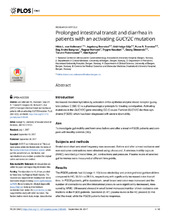| dc.contributor.author | Volkmann, Hilde Løland Von | en_US |
| dc.contributor.author | Brønstad, Ingeborg | en_US |
| dc.contributor.author | Gilja, Odd Helge | en_US |
| dc.contributor.author | Tronstad, Rune Rose | en_US |
| dc.contributor.author | Sangnes, Dag André | en_US |
| dc.contributor.author | Nortvedt, Ragnar | en_US |
| dc.contributor.author | Hausken, Trygve | en_US |
| dc.contributor.author | Dimcevski, Georg Gjorgji | en_US |
| dc.contributor.author | Fiskerstrand, Torunn | en_US |
| dc.contributor.author | Nylund, Kim | en_US |
| dc.date.accessioned | 2018-08-07T13:00:15Z | |
| dc.date.available | 2018-08-07T13:00:15Z | |
| dc.date.issued | 2017 | |
| dc.Published | Volkmann HLV, Brønstad I, Gilja OH, Tronstad RR, Sangnes DA, Nortvedt R, Hausken T, Dimcevski G, Fiskerstrand T, Nylund K. Prolonged intestinal transit and diarrhea in patients with an activating GUCY2C mutation. PLoS ONE. 2017;12(9):e0185496 | eng |
| dc.identifier.issn | 1932-6203 | |
| dc.identifier.uri | https://hdl.handle.net/1956/18025 | |
| dc.description.abstract | Introduction: Increased intestinal hydration by activation of the epithelial enzyme linked receptor guanylate cyclase C (GC-C) is a pharmacological principle for treating constipation. Activating mutations in the GUCY2C gene encoding GC-C cause Familial GUCY2C diarrhea syndrome (FGDS) which has been diagnosed with severe dysmotility. Aim: To investigate gut motility and hormones before and after a meal in FGDS patients and compare with healthy controls (HC). Subjects and methods: Bristol stool chart and stool frequency was assessed. Before and after a meal occlusive and non-occlusive contractions were obtained using ultrasound. A wireless motility capsule (WMC) recorded gut transit time, pH, contractions and pressure. Plasma levels of selected gut hormones were measured at different time points. Results: The FGDS patients had 4 (range 1–10) loose stools/day and prolonged total gut transit time compared to HC, 55.5 h vs 28.5 h, respectively,with significantly increased colon transit time. In FGDS patients, pH in duodenum, small bowel and colon was increased and the number of contractions and the intraluminal pressure were significantly decreased, measured by WMC. Ultrasound showed in small bowel increased number of non-occlusive contractions in the FGDS patients. Serotonin (5-HT) plasma levels in the HC peaked 30 min after the meal, while the FGDS patients had no response. Conclusion: Despite having diarrhea, the FGDS patients have prolonged transit time through the gut compared to HC, particularly in colon. The reduced number of intestinal contractions and lack of 5-HT release after a meal in FGDS patients surprisingly resemble colonic motility disturbances seen in patients with constipation. | en_US |
| dc.language.iso | eng | eng |
| dc.publisher | PLOS | eng |
| dc.rights | Attribution CC BY | eng |
| dc.rights.uri | http://creativecommons.org/licenses/by/4.0 | eng |
| dc.title | Prolonged intestinal transit and diarrhea in patients with an activating GUCY2C mutation | en_US |
| dc.type | Peer reviewed | |
| dc.type | Journal article | |
| dc.date.updated | 2018-03-06T14:36:58Z | |
| dc.description.version | publishedVersion | en_US |
| dc.rights.holder | Copyright 2017 The Author(s) | |
| dc.identifier.doi | https://doi.org/10.1371/journal.pone.0185496 | |
| dc.identifier.cristin | 1570895 | |
| dc.source.journal | PLoS ONE | |

